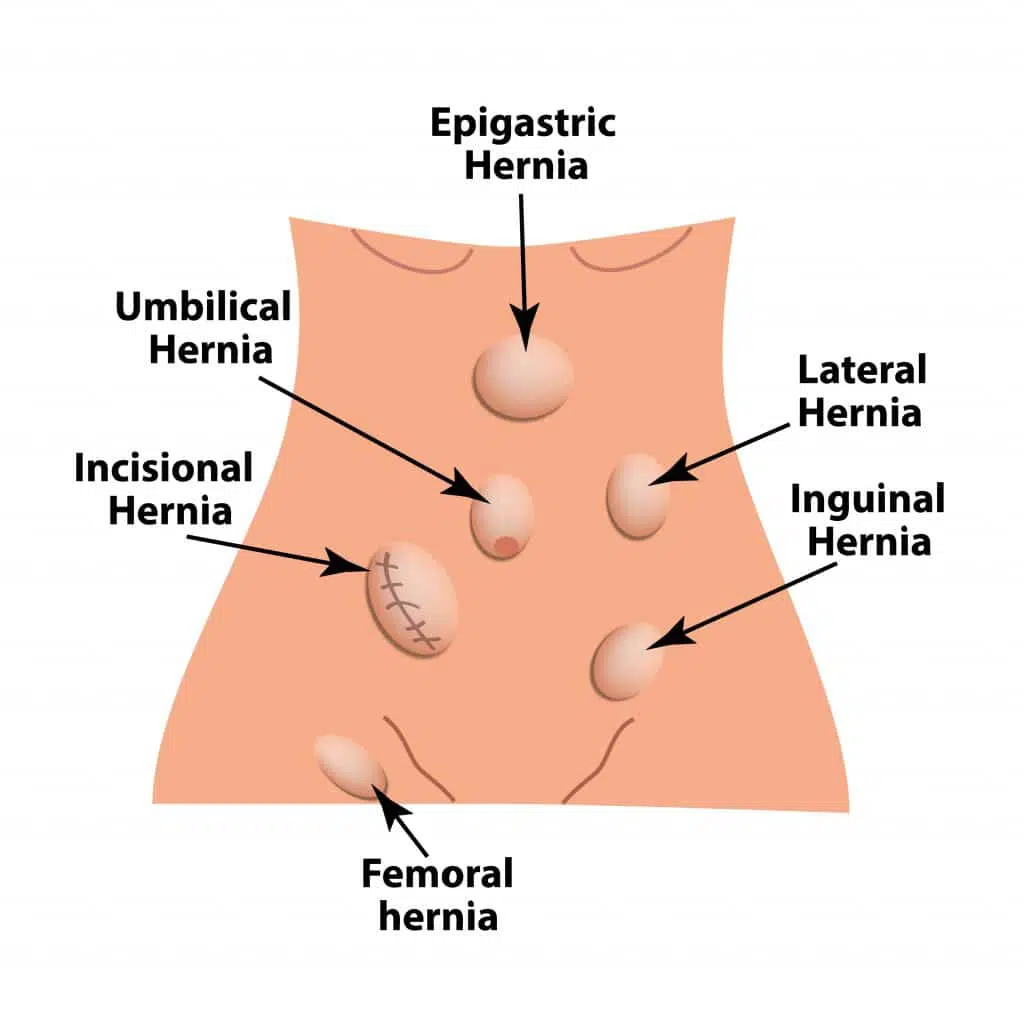Introduction:
Hernias are common medical conditions that occur when an organ or tissue protrudes through a weak spot in the surrounding muscle or connective tissue. While hernias can develop in various parts of the body, they most commonly occur in the abdominal area. Understanding the different types of hernias is crucial for proper diagnosis, treatment, and prevention. In this guide, we’ll explore the various types of hernias, their causes, symptoms, diagnosis, and treatment options.

Inguinal Hernia:
- Description: An inguinal hernia occurs when a portion of the intestine or abdominal tissue protrudes through a weak spot in the inguinal canal, which is located in the groin area.
- Causes: Inguinal hernias can develop due to factors such as heavy lifting, straining during bowel movements, persistent coughing, or congenital weakness in the abdominal wall.
- Symptoms: Common symptoms include a visible bulge in the groin area, discomfort or pain, especially when lifting or bending, and a feeling of heaviness or pressure in the groin.
- Diagnosis: Diagnosis is typically made through a physical examination, where the healthcare provider may feel for the presence of a bulge in the groin. Imaging tests such as ultrasound or MRI may be ordered to confirm the diagnosis.
- Treatment: Treatment usually involves surgical repair to reinforce the weakened abdominal wall and return the protruding tissue to its proper position. Laparoscopic or open surgery may be performed based on the individual’s condition and preference.
Hiatal Hernia:
- Description: A hiatal hernia occurs when a portion of the stomach protrudes through the diaphragm into the chest cavity, usually through the esophageal hiatus.
- Causes: Hiatal hernias can be caused by factors such as weakening of the diaphragm muscle, increased pressure on the abdomen (e.g., obesity, pregnancy), or injury to the area.
- Symptoms: Symptoms may include heartburn, chest pain, difficulty swallowing (dysphagia), regurgitation of stomach acid, and belching.
- Diagnosis: Diagnosis is typically made through imaging tests such as X-rays, barium swallow, or endoscopy to visualize the hernia and assess its size and severity.
- Treatment: Treatment may involve lifestyle changes (e.g., weight loss, avoiding trigger foods), medications to reduce stomach acid production, or surgery to repair the hernia and restore the stomach to its normal position.
Umbilical Hernia:
- Description: An umbilical hernia occurs when a portion of the intestine or abdominal tissue protrudes through the abdominal wall near the navel (umbilicus).
- Causes: Umbilical hernias can develop due to factors such as obesity, pregnancy, heavy lifting, or a congenital weakness in the abdominal wall.
- Symptoms: Symptoms may include a visible bulge near the navel, discomfort or pain, especially when coughing or straining, and tenderness or swelling at the hernia site.
- Diagnosis: Diagnosis is typically made through a physical examination, where the healthcare provider may feel for the presence of a bulge near the navel. Imaging tests such as ultrasound may be ordered to confirm the diagnosis.
- Treatment: Small umbilical hernias may close on their own over time, but larger or symptomatic hernias usually require surgical repair to strengthen the abdominal wall and prevent recurrence.
Ventral (Incisional) Hernia:
- Description: A ventral hernia, also known as an incisional hernia, occurs at the site of a previous abdominal surgery incision, where the abdominal tissue protrudes through the weakened scar tissue.
- Causes: Ventral hernias can develop due to factors such as inadequate healing of the surgical incision, increased intra-abdominal pressure, or weakening of the abdominal muscles over time.
- Symptoms: Symptoms may include a visible bulge or lump at the site of the surgical scar, discomfort or pain, especially when lifting or straining, and digestive issues such as nausea or constipation.
- Diagnosis: Diagnosis is typically made through a physical examination, where the healthcare provider may feel for the presence of a bulge at the incision site. Imaging tests such as ultrasound or CT scan may be ordered to assess the size and location of the hernia.
- Treatment: Surgical repair is usually necessary to close the hernia defect and reinforce the weakened abdominal wall. Depending on the size and complexity of the hernia, laparoscopic or open surgery may be performed.
Conclusion:
Understanding the different types of hernias is essential for recognizing the signs and symptoms, seeking timely medical attention, and exploring appropriate treatment options. If you suspect you have a hernia or are experiencing symptoms associated with a hernia, it’s important to consult with a healthcare professional for proper evaluation and management. With early diagnosis and intervention, hernias can be effectively treated, reducing the risk of complications and improving quality of life.
